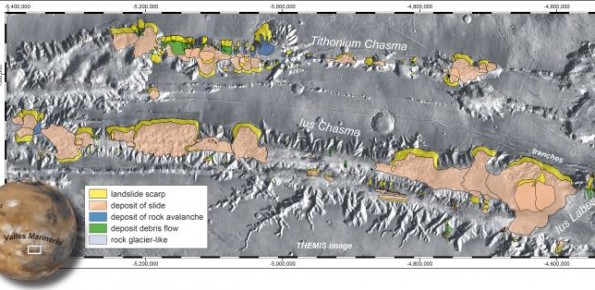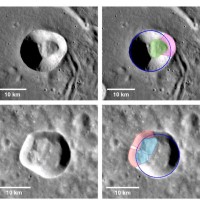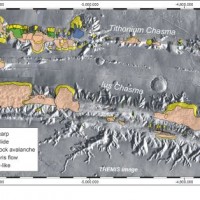Extraterrestrial landslides
Recognition, mapping, classification and statistical analysis of landslide size distributions on Mars, Moon, and Mercury

Background
Landslides play an important role in the evolution of landscapes on Earth and on other solid planets of the Solar System. Surface gravity is the main factor driving landslides in solid planets. On Earth, landslides have been recognized in all continents, and in subaerial and submarine environments. The spatial and temporal range of the observed slope failures is extremely large on Earth. We are conducting a systematic mapping of landslides in different solid bodies of the Solar System (Mars, the Moon, and Mercury). For each landslide, the information includes the geographical position, the geometry of landslide and of its individual elements (scarp and deposit area). We characterize the mass movements using terrestrial categories, which include rock slides, rock avalanches, and flows. We investigate the size (i.e., area and volume) statistics of the mapped landslides.
Purpose
Comparison of landslide characteristics on various planetary bodies may help in understanding the effect of surface gravity on failure initiation and propagation.
Methods
We are mapping extraterrestrial landslides in Valles Marineris, Mars, and along the internal walls of impact craters on the Moon and Mercury. To recognize and map the landslides on the three Solar System bodies, we adopt the same visual criteria commonly used by geomorphologists to identify and mapping terrestrial slope failures in aerial photographs or satellite images.
Results
The extraterrestrial landslides resulted significantly larger than their terrestrial equivalents. We obtain indications on the effect of the different surface gravity on landslides on Earth, Mars the Moon and Mercury through the analysis of the landslide size. We hypothesize that the lack of medium size (105÷107 m2) landslides on Mars is due to the absence of erosive processes, which are induced on Earth chiefly by water.
Products
Brunetti, M.T., Guzzetti, F., Cardinali, M., Fiorucci, F., Santangelo, M., Mancinelli, P., Komatsu, G., Borselli, L., 2014. Analysis of a new geomorphological inventory of landslides in Valles Marineris, Mars. Earth Planet. Sci. Lett. 405, 156–168. Doi:10.1016/j.epsl.2014.08.025.
Conclusions
We find that gravity is key to explain the difference between the distribution of the landslide size on the different solid bodies of the Solar System.




